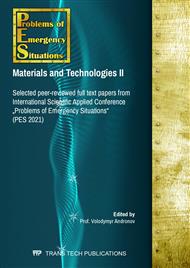[1]
H.H. Tulskyi, L.V. Liashok, H.S. Shevchenko, A.V. Vasilchenko, O.A. Stelmakh, Synthesis of functional nanocomposites based on aluminum oxides, Functional Materials, 26(4) (2019) 718-722.
Google Scholar
[2]
J.M. Macak et al. TiO2 nanotubes: Self-organized electrochemical formation, properties and applications, Current Opinion in Solid State and Materials Science. 11 (2007) 3–18.
DOI: 10.1016/j.cossms.2007.08.004
Google Scholar
[3]
Angela M. Raba, Jorge Bautista-Ruíz, Miryam R. Joya, Synthesis and Structural Properties of Niobium Pentoxide Powders: A Comparative Study of the Growth Process, Materials Research 19(6) (2016).
DOI: 10.1590/1980-5373-mr-2015-0733
Google Scholar
[4]
B.I. Bajrachny`j, V.N. Gurin, L.V. Lyashok, Fiziko-khimicheskie osnovy` proizvodstva oksidno-poluprovodnikovy`kh kondensatorov. K.: UMK VO, 1992 [in Russian].
Google Scholar
[5]
I. Sieber, H. Hildebrand, A. Friedrich, P. Schmuki, Formation of self-organized niobium porous oxide on niobium, Electrochemistry Communications. 7 (2005) 97–100.
DOI: 10.1016/j.elecom.2004.11.012
Google Scholar
[6]
G. Korotcenkov, Metal oxides for solid-state gas sensors: What determines our choice? Materials Science and Engineering B. 139 (2007) 1–23.
DOI: 10.1016/j.mseb.2007.01.044
Google Scholar
[7]
J.E. Yoo, J. Park, G. Cha et al. Micro-length anodic porous niobium oxide for lithium-ion thin film battery applications, Thin Solid Films. 531 (2013) 583–587.
DOI: 10.1016/j.tsf.2013.01.062
Google Scholar
[8]
J.Z. Ou, R.A. Rani, M.H. Ham, Elevated temperature anodized Nb2O5: a photoanode material with exceptionally large photoconversion efficiencies, Acsnano. 6(5) (2012) 4045–4053.
DOI: 10.1021/nn300408p
Google Scholar
[9]
S. Singh, W. Barden, P. Kruse, Nanopatterning of transition metal surfaces via electrochemical dimple array formation, Acsnano. 2(12) (2008) 2453–2464.
DOI: 10.1021/nn8003789
Google Scholar
[10]
Jianling Zhao, Xixin Wang, Rongqing Xu et al. Preparation and growth mechanism of niobium oxide microcones by the anodization method, Electrochemical and Solid-State Letters. 10(4) (2007) 31–33.
DOI: 10.1149/1.2458528
Google Scholar
[11]
K. Nakajima, T. Fukui, H. Kato et al. Structure and Acid Catalysis of Mesoporous Nb2O5·nH2O, Chem. Mater. 22(11) (2010) 3332–3339.
Google Scholar
[12]
Basamat S. Shaheen, Timothy C. Davenport, Hanadi G. Salem, Sossina M. Haile and Nageh K. Allam, Rapid and controlled electrochemical synthesis of crystalline niobium oxide microcones. MRS Communications, 5(3) (2015) 495–501.
DOI: 10.1557/mrc.2015.43
Google Scholar
[13]
L. Skatkov, L Lyashok, V. Gomozov, I. Tokareva, B. Bayrachniy, Аnodic formation of nanoporous crystalline niobium oxide. Journal of Electrochemical Science and Engineering. 4(2) (2014) 75-83.
DOI: 10.5599/jese.2014.0050
Google Scholar
[14]
I.M. Ryshchenko, I.V. Lyashok, V.P. Gomozov, S.A. Vodolazhchenko, S.G. Deribo, Formation of nanostructures on the basis of porous anodic niobium oxide, Functional materials. 26(4) (2019) 729–733.
Google Scholar
[15]
S.V. Ivanov, Nestaczionarnaya vol`tamperometriya: diagnosticheskie kriterii metoda, Khimiya i tekhnologiya vody`. 18(1) (1996) 3–52 [in Russian].
Google Scholar
[16]
Kai Skrodczky, Margarida M. Antunes, Xianying Han, Saveria Santangelo, Gudrun Scholz, Anabela A. Valente, Nicola Pinna & Patrícia A. Russo, Niobium pentoxide nanomaterials with distorted structures as efficient acid catalysts, Communications Chemistry. 2 (2019) 129.
DOI: 10.1038/s42004-019-0231-3
Google Scholar
[17]
Dinithi Rathnayake, Inosh Perera, Alireza Shirazi-Amin, Peter Kerns, Shanka Dissanayake, and Steven L. Suib, Mesoporous Crystalline Niobium Oxide with a High Surface Area: A Solid Acid Catalyst for Alkyne Hydration, ACS Appl. Mater. Interfaces. 12(42) (2020) 47389–47396.
DOI: 10.1021/acsami.0c10757
Google Scholar


